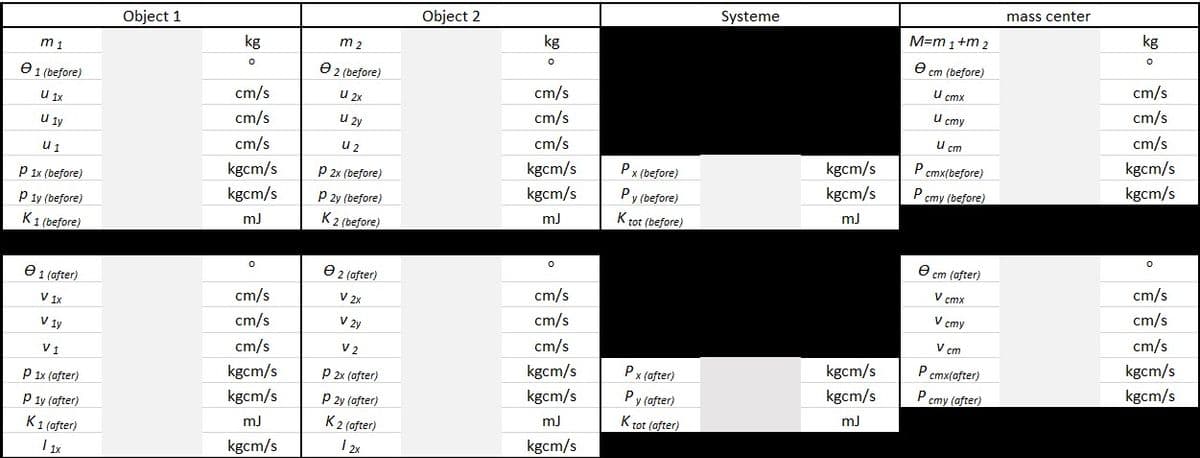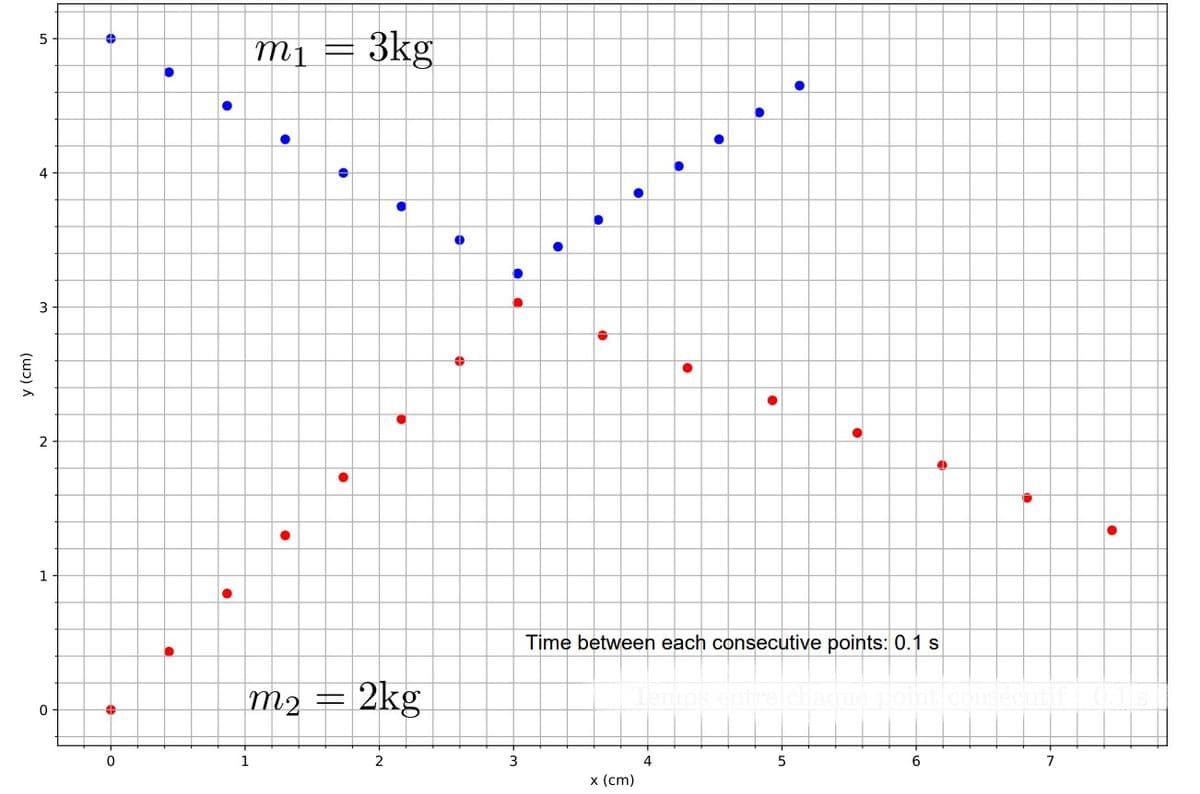Instructions: With the simulation in picture 1 complete the table in picture 2. To do this: Measure the velocity orientation of each mass before and after the collision using an angle protractor. Give the angle to the positive x-axis. (1 (before), 2 (before), 1 (after), 2(after)) 2. Calculate your speeds before and after the collision according to the components x and y. (u1x, u2x, u1y, u2y, v1x, v2x, v1y, v2y) 3. Find the speed of each mass before and after the collision. ( u1; u2; v1; v2) 4. Calculate the amount of motion of each mass before and after the collision as well as the total amount of motion of your mass system always according to x and y. (p1x (before), p1x (after), p2x (before), p2x (before), p1y (before), p1y (before), p2y (before), p2y (after), Px (before), Px (after), Py (before), Py (after)) 5. Calculate the kinetic energy of each mass and the total kinetic energy before and after the collision. (K1 (before), K1 (after), K2 (before), K2 (after), Ktot (before), Ktot (after)) 6. Calculate the collision pulse in x only (I1x, I2x) 7. On the collision trail, identify the location of the center of mass for each time. It is first necessary to connect the points between the masses corresponding to identical times. Connect your centers of mass before the collision and after the collision 8. Measure the speed orientation of the center of mass forward and after the collision using an angle protractor. Give the angle to the positive x-axis. (Cm (before), cm (after)) 9. Calculate your center of mass speeds before and after the collision according to the x and y components (ucmx, ucmy,vcmx, vcmy) 10. Find the speed of the center of mass before and after the collision. (ucm, vcm) 11. Calculate the amount of motion of the center of mass before and after the collision always according to x and y. (Pcmx (before), Pcmx (after), Pcmy(before), Pcmy(after)) Here, this should help analyze your results. The amount of motion of each individual mass should not be preserved. The total amount of motion should be preserved (about 5%). The kinetic energy of each mass should not be conserved. The total kinetic energy could or could not be conserved depending on the type of collision. Here, the collision is inelastic. It is up to you to see if your results are in line with this index. Compare the impulse of the two masses. It should be identical but of the opposite sign, because the forces applied in a collision are always equal and opposed (this is the third law of Newton).
Instructions:
With the simulation in picture 1 complete the table in picture 2. To do this:
- Measure the velocity orientation of each mass before and after the collision using an angle protractor. Give the angle to the positive x-axis. (1 (before), 2 (before), 1 (after), 2(after))
2. Calculate your speeds before and after the collision according to the components x and y. (u1x, u2x, u1y, u2y, v1x, v2x, v1y, v2y)
3. Find the speed of each mass before and after the collision. ( u1; u2; v1; v2)
4. Calculate the amount of motion of each mass before and after the collision as well as the total amount of motion of your mass system always according to x and y. (p1x (before), p1x (after), p2x (before), p2x (before), p1y (before), p1y (before), p2y (before), p2y (after), Px (before), Px (after), Py (before), Py (after))
5. Calculate the kinetic energy of each mass and the total kinetic energy before and after the collision. (K1 (before), K1 (after), K2 (before), K2 (after), Ktot (before), Ktot (after))
6. Calculate the collision pulse in x only (I1x, I2x)
7. On the collision trail, identify the location of the center of mass for each time. It is first necessary to connect the points between the masses corresponding to identical times. Connect your centers of mass before the collision and after the collision
8. Measure the speed orientation of the center of mass forward and after the collision using an angle protractor. Give the angle to the positive x-axis. (Cm (before), cm (after))
9. Calculate your center of mass speeds before and after the collision according to the x and y components (ucmx, ucmy,vcmx, vcmy)
10. Find the speed of the center of mass before and after the collision. (ucm, vcm)
11. Calculate the amount of motion of the center of mass before and after the collision always according to x and y. (Pcmx (before), Pcmx (after), Pcmy(before), Pcmy(after))
Here, this should help analyze your results.
The amount of motion of each individual mass should not be preserved.
The total amount of motion should be preserved (about 5%).
The kinetic energy of each mass should not be conserved.
The total kinetic energy could or could not be conserved depending on the type of collision. Here, the collision is
inelastic. It is up to you to see if your results are in line with this index.
Compare the impulse of the two masses. It should be identical but of the opposite sign, because the forces applied in a collision are always equal and opposed (this is the third law of Newton).


Step by step
Solved in 2 steps









